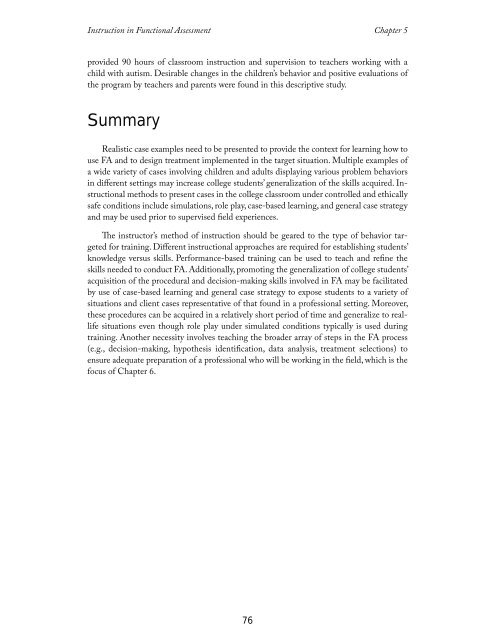Instruction in Functional Assessment, 2014a
Instruction in Functional Assessment, 2014a
Instruction in Functional Assessment, 2014a
Create successful ePaper yourself
Turn your PDF publications into a flip-book with our unique Google optimized e-Paper software.
<strong>Instruction</strong> <strong>in</strong> <strong>Functional</strong> <strong>Assessment</strong> Chapter 5<br />
provided 90 hours of classroom <strong>in</strong>struction and supervision to teachers work<strong>in</strong>g with a<br />
child with autism. Desirable changes <strong>in</strong> the children’s behavior and positive evaluations of<br />
the program by teachers and parents were found <strong>in</strong> this descriptive study.<br />
Summary<br />
Realistic case examples need to be presented to provide the context for learn<strong>in</strong>g how to<br />
use FA and to design treatment implemented <strong>in</strong> the target situation. Multiple examples of<br />
a wide variety of cases <strong>in</strong>volv<strong>in</strong>g children and adults display<strong>in</strong>g various problem behaviors<br />
<strong>in</strong> different sett<strong>in</strong>gs may <strong>in</strong>crease college students’ generalization of the skills acquired. <strong>Instruction</strong>al<br />
methods to present cases <strong>in</strong> the college classroom under controlled and ethically<br />
safe conditions <strong>in</strong>clude simulations, role play, case-based learn<strong>in</strong>g, and general case strategy<br />
and may be used prior to supervised field experiences.<br />
The <strong>in</strong>structor’s method of <strong>in</strong>struction should be geared to the type of behavior targeted<br />
for tra<strong>in</strong><strong>in</strong>g. Different <strong>in</strong>structional approaches are required for establish<strong>in</strong>g students’<br />
knowledge versus skills. Performance-based tra<strong>in</strong><strong>in</strong>g can be used to teach and ref<strong>in</strong>e the<br />
skills needed to conduct FA. Additionally, promot<strong>in</strong>g the generalization of college students’<br />
acquisition of the procedural and decision-mak<strong>in</strong>g skills <strong>in</strong>volved <strong>in</strong> FA may be facilitated<br />
by use of case-based learn<strong>in</strong>g and general case strategy to expose students to a variety of<br />
situations and client cases representative of that found <strong>in</strong> a professional sett<strong>in</strong>g. Moreover,<br />
these procedures can be acquired <strong>in</strong> a relatively short period of time and generalize to reallife<br />
situations even though role play under simulated conditions typically is used dur<strong>in</strong>g<br />
tra<strong>in</strong><strong>in</strong>g. Another necessity <strong>in</strong>volves teach<strong>in</strong>g the broader array of steps <strong>in</strong> the FA process<br />
(e.g., decision-mak<strong>in</strong>g, hypothesis identification, data analysis, treatment selections) to<br />
ensure adequate preparation of a professional who will be work<strong>in</strong>g <strong>in</strong> the field, which is the<br />
focus of Chapter 6.<br />
76


















